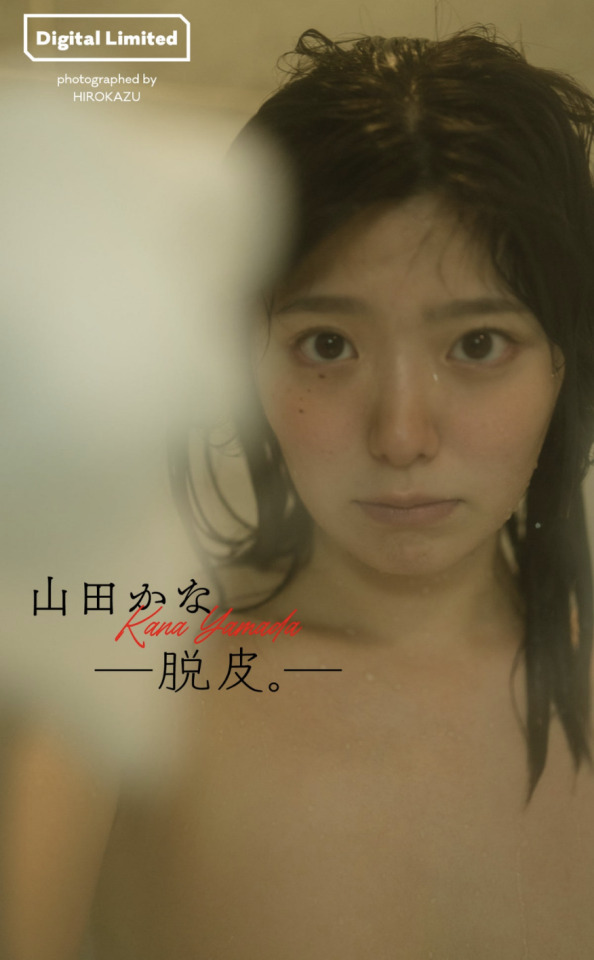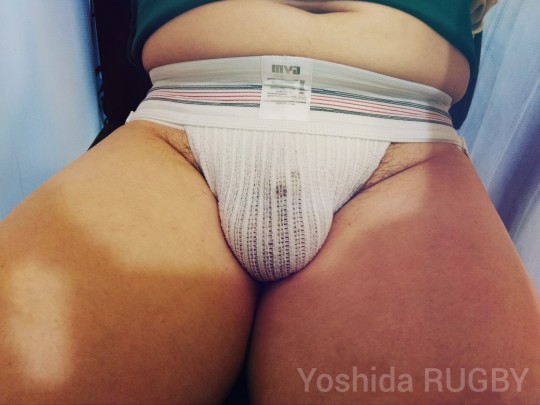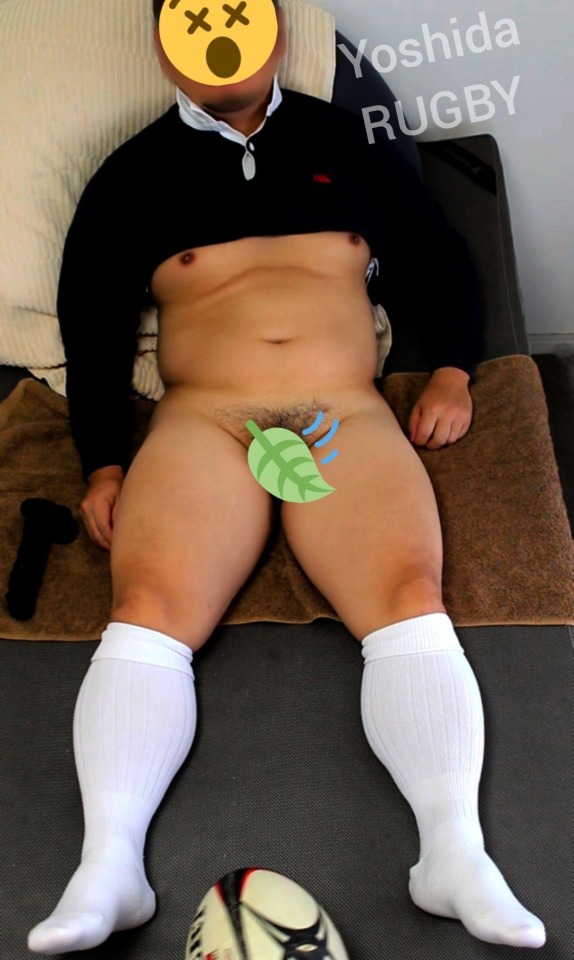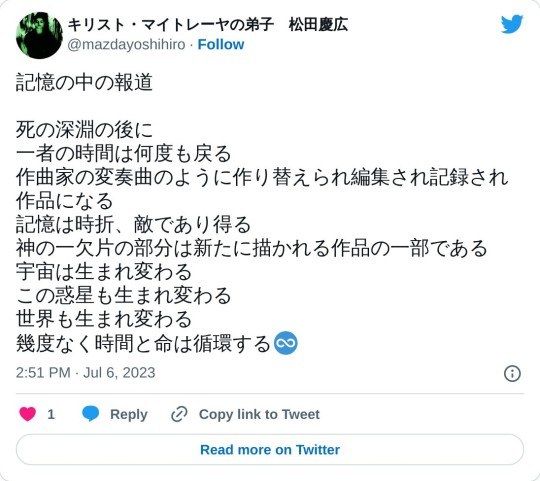#新しい時代
Explore tagged Tumblr posts
Text
なんという
いたわりと
友愛じゃ……
1 note
·
View note
Text
数名から投稿楽しみにしているとリクエストがあったので、久しぶりに投稿。
年末年始にヨーロッパにいる友人に会うため旅行したのだが、友人と会った最初の2日間以降は一人旅。
某国の首都を訪問し観光したその夕方、某ゲイ用の出会い系アプリを開いて見ていたら、早速何人かからメッセージが。その中で写真とプロフが気に入った37歳の男が一緒にキメてやろうと誘ってきたので、その夜指定の場所に行って会うことに。
ホテルからタクシーで10分くらいの指定された住所で降りて部屋の場所を尋ねると、そいつはその目の前にあるバーで待っていると。恐る恐るそのバーの入り口を入ると、その男は���っていた。慎重180cmくらいの体格のいい男前だった。既に俺の入場料も払ったからと中に案内された。入り口のエリアはゲイバーなのだが、奥はゲイ用のレンタルルームとクルージングスペースになっているらしく、バーから奥の廊下に入ると薄暗く、廊下には多くの男達がいた。普段着の奴もいれば、上半身裸とか、革のハーネスとケツ割れ姿だけの奴など、年齢も20代~60代くらいと思われる奴までいろいろ。レンタルルームへ向かう途中廊下にいる男達と目があうが、何人かは気軽に挨拶してくる。中には早速ケツを触る奴も。ドキドキしながら部屋に向かった。
レンタルルームに入ると、薄暗い部屋にダブルベッドとシャワーブースのみがあり、ベッドの上には既に他の奴とやっていたと思われるキメ道具やゴミなどがあった。すぐに服を脱ぎ、ホテルから装着して来たハーネスとケツ割れ姿に(コックリングも装着済み)なると、すぐにどれだけ入れる?と聞いてきたので、自分でやると言って、10メモくらいをもらって新しい注射器にセット。それぞれベッドの上で入れ終わるや否や、カーッと体が熱くなり、すぐにエロモードに。ベロチューでスタートしたが、すぐにその男がチンコをしゃぶってと言って俺の口にチンコを押し込んできたが、いきなりのデカマラにむせながらもむさぼり付くように竿から金玉までしゃぶりまくった。そのまま69になりお互いのチンコをしゃぶっていたら、俺のケツの穴にその男の長い舌が入ってきて、そのまましばらくケツをなめられる状況に。俺はタチの頃からケツを舐められるのは好きだったので、そいつの長い温かい舌がケツの穴の中を舐め回る度にガマン汁垂らしまくって唸ってた。「綺麗なケツだ」と言われ、四つん這いで散々ケツと玉と竿を舐められた後は、そのままギンギンになった彼のデカマラが押し込まれた。突然デカいのが入ってきたので痛みで30秒くらい抜かずにストップしてもらったあとは、しばらくずっと掘られっぱなし。デカいのをピストン運動する度うめき声が抑えられず、おそらく廊下まで響いていたと思う。俺のチンコからはガマン汁はダダ漏れで、このままじゃ掘られて終わっちゃうよって思ったら、いきなり強く腰をビクンビクンと突き上げ種漬けされた。量が多いのか、ケツの奥に温かさと満腸感でイッたことがすぐ分かった。その男は既に俺が数人目みたいだったので、疲れたのでしばらく休憩すると。あなたはクルージングエリアに行って遊んできたらいいよって言われたので、まだ掘ってないし全然やり足りない俺はムラムラ全開のまま初めてのヨーロッパでのクルージングゾーンに。部屋から出てロッカーに荷物を預け、ワクワクしながら廊下の奥へ。そのフロアには多くのビデオルームが廊下の両サイドにあり奥に深く回廊の様になっていた。その男達が沢山いる通路をハーネス、ケツ割れ、ブーツ姿で歩くというのはさすがの俺も初めてで恥ずかしさと���張感があったが、すれ違う男達に"Wow!", "Nice!"などと言われ、すぐに何人かに誘われた。とりあえずそのまま一つのビデオルームに入ると、部屋の上の方のテレビでゲイビデオが20チャンネルくらい選べるしくみで、両側の部屋との間にでかいGlory Holeが空いていた。あちこちでビデオの声とは別にしゃぶっている音や、ケツを掘っている音などが聞こえ、キメているのにさらにアガりまくり。椅子に座るといきなり両側からデカいチンコがヌッと出てきた。なんでこの国の男はみんなチンコがデカいんだよって驚きながらも、早速片側のデカマラにしゃぶりつく。口いっぱいの太さの皮付きのデカマラのエロさに俺のチンコはビンビンダラダラ。夢中でしゃぶっていたら、隣の穴から腕が出てきて俺のケツをひっぱられ、そのままケツを突き出したら穴からけつの穴をペロペロと舐め始めた。あまりの気持ちよさとエロさにうめき声を出しながらデマからを必死でしゃぶった。隣のデカマラもしゃぶりたかったので、向きを変えて何度か交代でデカマラをしゃぶりながらケツを舐められていたが、突然固い太いチンコが俺のケツに入ってきた。あまりの変態なシチュエーションに興奮してうめき声を漏らしたが、その後は3度ほど交代で反対側の男にケツを掘られ、最初の男がうめき声とともに俺のケツに中出しをしたかと思ったら、しゃぶっていたデカマラがビクンとしたと同時に俺の口の中に大量のザーメンが噴射された。それぞれの男は”Thank you"と言って部屋を出て行ったが、同時にケツと口の中がザーメンでいっぱいになった俺は変態度が半端ないレベルだったのでそのままザーメンを飲み込み、ケツの穴にぶち込まれた二人目のザーメンもそのままキープしてビデオルームを出た。ますます変態度が上がり、ムラムラ最高潮の俺はそのまま廊下を一歩きしていたら、地下に続く階段が。ワクワクしながら階段を降りると、さらに広いクルージングゾーンが。大きなスクリーンでゲイビデオ放映している広間の左右に伸びる廊下は迷路のようなダークゾーンで、鉄格子と鎖などがぶら下がっているハードなエリア、ケツ掘りブランコルームやX字の形に4つの革ベルトが付いたSM?プレイルーム、ケツ掘りベンチや叉を開く医療用のベッドのようなベンチなど、いろいろなエリアが。既にやりまくっている奴らもいてあちこちで声が響いている。多くのムラムラした男達が獲物を探して歩き回っているが、俺の格好がハレンチだったのか、アジア人が珍しかったのか、暗い廊下では男達に声をかけまくられた。その、地下のクルージングエリアでのエロ体験についてはまた次回書きます(長文でちょっと疲れた)。自分がこんなにも変態だったことを改めて知ることになったエロい体験談はまた次回に。
349 notes
·
View notes
Text
2025-01-12
【俺と 親父とおっちゃんと 】
コロナ禍ちょっと前、6年くらい前のこと。
お盆休みで地元に帰ってて、大阪に戻る時におっちゃん(親父の幼馴染)のトラックが関西便があるって事で、おっちゃんのトラックで戻って来る車内でのこと。
「〇〇〇(俺)はまだ結婚しとらんし、もしかしてあれか、あっちの気とかあるんか?」
て聞いてきた。
たしかに、40前後で女っ気ないし、おっちゃんとトラックでズリ合い��る時は、ズリネタはおっちゃんのエロ本とか、男女モノDVDやけど、おっちゃんとチンポ握り合ってズリ合いとかしてるんやから
「あっちの気」って思われても仕方ないわなw
だからそう思われてるなら、逆に言えるチャンスと思って
「セックスは両方イケる」て、エロに関してはバイってことで、とりあえず凌いだ。
寸前で「ゲイ」とは言えなかったのは、ノンケ同士ぽい関係が好きだったからかな。
そしたら、おっちゃんが
「あー、やっぱりそうか思うたわ。ワシも両方いけるんで。でも、おまえはどっちとやるんがええんや?」
てお互いにバイってことになって、でも俺はノンケ寄りを装って、チンポ入れるんはマンコやなぁ」て言うたかな(笑)
おっちゃんは「ワシも若い頃は女の方が多かったな」
て言うたから「じゃあ、今は女より男んが多いん?」て聞いたら、『遊ぶんは男やな』て。
トラックの中では、お互い初めて男とやった時のエロ体験や、俺と親父とのこととか話して、俺もおっちゃんもチンポガチガチw
パーキングエリアに停めて、窓のカーテン締めてシートの後ろの1畳くらいのスペースに移って、とりあえず下だけ脱いでセンズリ。
エロ本もなんもいらん、お互いに胡座かいて壁に寄りかかって、無言で俺はおっちゃんの、おっちゃんは俺のセンズリを見ながら抜いた。
それまでも、ズリ合いはしたことあったけど、お互いに男ともヤるって知ってからのズリ合いは、親父と息子ほど離れた男ふたりが、それぞれに男を意識して男同士で見せつけるセンズリは改めて興奮したな。
おっちゃんと無言で向い合うも、おっちゃんがシャツの裾を首に掛けて乳首を弄れば、俺も返すようにシャツを首に掛けて乳首を弄りながらチンポ扱く。
胡座かいてた足が緩く解けて、乳首の刺激やチンポがガマン汁垂らすたびに、足がビクッと動く。おっちゃんの親指と俺の親指が何度か当たるうちに、もう避けることなく足と足を絡ませる。
おっちゃんがケツを下に滑らせて、俺の金玉を足で潰すように押し付けてくる。俺も同じようにおっちゃんの金玉を潰すように足を押し付ける。
指の股で玉袋を引き下げられた俺のチンポは、亀頭がパンパンに張り、一気にザーメンが上がるのを感じた。おっちゃんが金玉を潰すように更に足を押し付けてきた時に
「おっちゃん、俺いきそうやわ」
と、口に出た。
おっちゃんは、俺の目を一瞬見て自分のチンポを扱く手を早めた。
「もうちょい待てよ、一緒に出すで」
と、おっちゃんは乳首を弄ってた手を自分の金玉に伸ばして金玉を引き下げながら、太いチンポを握り直して、深く息を吸って
「おし、ワシも出すで、◯◯◯ももう好きな時に出せ」
おっちゃんから、射精許可を出されたようで俺はおっちゃんの言葉に興奮して、何故か敬語でおっちゃんに叫んでた。
もういきそうです!チンポ限界です!
あっ、あ、出ます!出ます!出まっ、、、
「あー、ワシもいくで!」「あっ、出る!、出る!」
と、俺が腹に出すのと同時くらいに合わせておっちゃんも自分の腹にザーメンをぶち撒けた。
「はぁ、はぁ、はぁ」
はぁ、はぁ、はぁ
と、暫くザーメンを拭き取るのも忘れて2人の荒い呼吸が落ち着くのを待った。
車内でセンズリする時は、ザーメン飛び散らんようにティッシュにだしたり、腹に出して拭く。ゴム付けてそのままゴムの中に出す時も。
丸まって山になったザーメンティッシュをコンビニ袋に詰めて、パーキングのゴミ箱に捨てに行くんやけど、他のトラックドライバーもなのか、ティッシュしか入ってないようなコンビニ袋がゴミ箱横にも置いてある。
これが、家族連れや、バス旅行の人とかトラックドライバー以外の人も多いサービスエリアとは違うとこ。
パーキングエリアは、トイレと自販機くらいって所が多いので、休憩するトラックが多いね。
乳白色のコンビニは街灯に透けて、丸まったティッシュのシワの影や、緑色やピンク色の伸びたゴムも分かる。そんなコンビニ袋がゴミ箱から溢れる。
どんだけ福袋の山やねんと、その誰のザーメンか分からん袋を持って帰りたくなる(笑)
1発抜いてスッキリしたら再び大阪に向けて出発。
明け方に大阪に到着して、俺を降ろしてからおっちゃんは荷下ろし先へ。
その日はそれで終わり。
そのおっちゃんから、緊急事態宣言明けたタイミングで、京都便があるからそっち方面行くで。
て、連絡があってん。
で、その数日後に親父から「▲▲▲(おっちゃん)がトラックで京都行くからワシも行くわ」て連絡があって、久しぶりに親父も泊まると思ってたら、新世界で飲むからそのまま難波辺りのサウナで寝るわ、って。
なんや、残念と思ってたら前日におっちゃんから、「■■■(親父)とロイヤル泊まるんやけど来るか?」
て、メールがあってん。
新世界のロイヤル言うたら大型ゲイサウナやねん。
「親父、ロイヤルがゲイサウナって知ってるん?」
て、おっちゃんに聞いたら「詳しくは言うてないけど
『あっち系の男専用サウナ』とは言うてるで。
個室も取るし、アイツもええって言うとるしの」
俺は「ゲイサウナて分かってて行くって、親父はバイなんやろか?」
て、めちゃドキドキしてきて、ドキドキすんねんけど
男がアカンかったら、風呂場とか大部屋とかでトラブったら嫌やなと思ってん。
おっちゃんもそれくらい分かるやろうに、なんでロイヤルにしたんやろ?
と思ってんけど、これは後日、親父がバイって分かる時が来るんやけど、親父とおっちゃんは学生時代から男とも、女ともエロはやってたらしい。親父は基本的には女がええけど、おっちゃんは親父とやりたいて思ってたらしいわ。
ロイヤルの風呂場にはシャワーブースが5つ並んでて仕切の腰辺りの高さに穴が開けてあって、そこから隣を覗いたりチンポ突っ込んだりできるように���っとんの。
親父と顔合わすのはマズイからこのシャワーブースは丁度いいねん(笑)
おっちゃんに時間を聞いて俺はその時間に合わせて先に風呂入ってシャワーブースに入る。
目印に、ドアの上にタオルを外に垂らす。
隣りは空いてるけど、親父らが来る前に他の人が来たら段取りが狂うから、来ないこと願いながら待ってたら隣に誰か入って来てん。
穴から覗いたら、2人おる。
会話が地元の言葉やからすぐにおっちゃんと親父やと分かったわ
覗き穴は立ったまま上から覗くと角度的に向こうの足しか見えんから、俺ちょっとしゃがんで覗いたら、親父とおっちゃんのチンポが見えてん。
それだけでめちゃ興奮(笑)
で、親父たちの会話を聞いてたら、おっちゃんがこの穴の説明してた。
説明せんでも分かるやろ(笑)
で、おっちゃんがしゃがんで覗いてきたんで、確認の為に俺もおっちゃんを確認。
おっちゃんが親父に「〇〇〇(俺の名前)くらいの兄ちゃんがおるわ」て言いながら、おっちゃんが穴にチンポ突っ込んできた。
俺はおっちゃんの萎えたチンポ握って軽く扱いて、半勃ちくらいになったとこ咥えてわざとピチャピチャ音立ててしゃぶったら、おっちゃんも大げさに感じて、親父を誘う作戦は完璧。
やってんけど、おっちゃんのチンポしゃぶりながら俺もチンポ扱いてたからイキそうになってやばかった(笑)
本命は親父やからな(笑)
俺がおっちゃんのチンポしゃぶるの止めたら、おっちゃんがチンポ引っ込めて「■■■(親父)もしゃぶって貰えや」て、親父を仕切りの方に寄せてん。
こういう場で名前を呼ぶのはタブーやのに、幼馴染やと、名前で呼んでまうのが自然やわな。
俺は万が一、親父が覗き込んで来た時のために隙間を開けてタオルで薄っすら目隠しして、待っててん。
親父が一歩寄って壁にへばり付くようにして穴からチンポ出して来た。
目からタオルを取ると、壁穴から親父のチンポがボロンと垂れとる。
垂れとる言うても、萎えてるんやなくてちょっと半勃ちやったな。親父、おっちゃんが俺にしゃぶられんの見てて興奮したんかも(笑)
先ずは手を使わずに親父のズル剥けのドス黒い亀頭を舌先でつついて、引く感じもなかったからゆっくり亀頭吸い込むように咥えて、口の中で舌を這わせてウラ筋責めたらだんだん亀頭が張ってきて、親父のチンポがガチガチになってきた。
口を離して、根元から握って親父の血管ボコボコのチンポを目の前にしたら
もうおかしくなりそうで、また咥えて自分の唾と親父のガマン汁が口の中で混ざって口から垂らしながらしゃぶり続けてん。
壁の向こうで、おっちゃんが親父に、「しゃぶられとんか?気持ちええやろ?なぁ?」
『あぁ、奥までくわえとるわ、気持ちええっ』
て、親父のあんな感じとる声初めて聞いたから、めちゃ興奮してもうて、ふと思い付いてん。
「ケツやれるやん」
親父と顔は合わせんし、親父はまさか俺とは思ってないし。
しゃぶるん止めて、俺は立って壁穴にケツを向けて親父のチンポ当ててみてん。
親父はその感触でケツと分かったみたいでチンポ穴から抜いてもうてん。
あー、失敗やん、あのまましゃぶって親父のザーメン口に受けとき��良かったて、もっかいしゃがもうと思ったら、ケツに指が入ってきてん!
風呂場には、サウナが3つ、湯船が3つ、洗い場があって広いから他にも人はおるけど、シャワーブースはトイレの個室みたいになってるから、個室には誰も入って来れん。
「ケツできるかも!」
と、俺は壁穴にケツの穴が見えるようにケツを当ててたら、
親父がおっちゃんに「ゴムあるか?」て、おっちゃんがオイルもあるで、てゴム開けるカシャカシャする音と、ローションのボトルを開ける音がしてん。
親父がもっかい指を入れてきてんけど、ローション付いてるからグッと奥まで来て、声が出てもうてんけど風呂場やから聞こえんなと思って、「ケツやばい」とか口にしたら
「ケツ気持ちええんか」て親父が言うてきてめちゃ焦ったわ
あんまりハッキリ喋ると、親父の地元の言葉に引っ張られて俺も地元言葉になってまいそうやから、適当に返事して
ついに親父がチンポ当ててきたから、今しかチャンスないと思って、俺、壁からケツ離して壁に向いてしゃがんで、親父のゴムチンポしゃぶってん。
しゃぶる必要ないくらいもうガチガチやったけど、ひと細工せなあかんやろ?ゴムがピチピチで、先を噛み切るの苦労したわ(笑)
そう、ゴムに穴開けてん。
親父が違和感に気付いてチンポ引っ込めたら噛み切ったのバレるから、親父のチンポ掴んだまま壁にケツ向けてケツ押しあててんけど、デカマラ過ぎてなかなか入らん。
親父が壁から離れたら穴開きゴムがバレてまうなて時に、「兄ちゃん、チカラ抜いて息吐いてみ」
て、親父が言うてん。
こんなん言うのて、親父初めてやないやん、ケツ掘ったことあるやん?
て、想像したらケツがグワッと開いた感じがしてヌルンと亀頭が入ってきてん、
ズキンとジワジワと、最初は痛かってんけど一回抜いたら、もしかしたらゴムが破れてるかも知れんから、なんとかガマンして後はゆっくり入ってくんのを息吐きながら耐えて、全部入った時には俺のチンポ萎え萎えやったわ(笑)
「兄ちゃん、動かすで」
て声がして、親父が腰振りだした。
俺も壁から離れんように、ケツを壁に押しあてて前の壁に手を付く。目の前の壁にある鏡にデカマラに苦しみよがる俺の顔が映っとる。壁1枚やけど俺の後ろには親父がおって、穴開きゴムとも知らずに、そのケツが俺とも知らずに、もうとっくに噛み切ったゴムの穴は大きく裂けて、生チンポで俺の生ケツを掘る親父の姿があるんやと思ったらケツがキュッと閉まって、親父が「おぃ、兄ちゃんワシそろそろ出すで」て
言うて、ピストンが速くなったんやけど親父もそう直ぐにはいかんから、ガン掘りが5分くらい続いて俺の方が足も痛くなってきて、チンポ萎える前に掘られながらいきたかったから「俺も、イキそうです」て、タオル噛みながら言うてん。
そしたら親父が「出せ出せ、ワシも出るわ、ええか、このまま出すで」
「はい、このまま中で出して下さい!」
て、返したかったけどはっきりしゃべるとバレるから「はい、俺も、イクイクイク!」
あー、兄ちゃん、出るで!あっ、出る!出すで!
て、俺が先にいって親父も俺のケツの中でいってん。
親父がチンポ抜こうとしたからすかさず根元のゴムを掴んで、チンポ見たらゴムがリング状態で完全に生チンポやってん(笑)
直ぐにゴムを外してフェラして完了。
親父のザーメンの味は親父の使用済みオナホとかゴムで知ってたけど、チンポから直で舐めるんは初めてやったから、しゃぶりながら俺また勃ってもうて、しゃぶりながらセンズリしたわ(笑)
親父に生チンポで掘られて種付けされてみたいけど、絶対にあり得んと思ってたから、あのシャワーブースはめちゃ完璧なシチュエーションやったわ。
俺が先に出て、風呂から上がって俺は帰ってんけど、親父らは個室に泊まったわ。
最初におっちゃんと話してたんは、ドンキでプロレスとかショッカーのマスク買って、個室で3人でやろうとか言ってたんやけど、個室やと照明落としても喋るとバレるし、マスクしてるとフェラできんしって事でシャワーブースを思い付いたんやけど、結果正解やったな(笑)
今、思ってもあの壁穴付きシャワーブースはエロい。
親父もまさか自分の息子にしゃくられて、生チンポで息子に種付けしてるとは思ってないやろし(笑)
232 notes
·
View notes
Quote
以前、すき家のアルバイトに行ったが落ちました。本部では採用されると思うので制服のサイズとか入ってからの事を説明されました。 しかし、働く店舗側が店員満員になったということで断られました。 新しく入った方は全てネパールの方でした。 お客として、その後行った時ネパールの方は技能実習生だったのか日本語もカタコトでした。 なぜ日本人採用しないで全員ネパールの人なのか? 知り合いのネパール人に聞いたところ、会社にキックバックマネーが入るからだよと教えてもらいました。 外国人がたくさん増えてきて、これでは日本人のアルバイト先も少なくなると思いました。
働きたくても働けない40~50代前半が「完全に見捨てられている」雇用の打開策は?「1回、お��しでもいいから働かせて」(ABEMA TIMES)のコメント一覧 - Yahoo!ニュース
246 notes
·
View notes
Text

Happy New Year! I hope you have a wonderful year ahead. May this year be a more kind one for God and mankind. 新年明けましておめでとうございます!今年もどうぞよろしくお願いいたします。神にとって人間にとって益々優しい時代となりますように。
#2025#illustration#drawing#characters#original character#typography#torufukuda#fukudatoru#happynewyear
367 notes
·
View notes
Text







山田 かなは、日本のグラビアアイドル、タレント。千葉県出身。プラチナムプロダクション所属。 ウィキペディア
生まれ: 1995年9月27日 (年齢 29歳), 千葉県
身長: 156 cm
カップサイズ: G
スリーサイズ: 89 - 60 - 94 cm
デビュー: 2021年
事務所: プラチナムプロダクション
他の活動: タレント
趣味は筋トレなど体を動かすこと・犬と遊ぶこと、特技は料理・掃除。
憧れているのは、くりえみ。
高校卒業後、2年ほどOLとして営業の仕事をしていた。営業成績1位を取るも達成感からモチベーションが低下、また意地悪な先輩から「山田さんは、大学行っていないもんね」とたびたび嫌味を言われるのが悔しく、「あの人より良い大学に行ってや��!」と決意を固めて会社を辞め、勉強して大学生になった。現在、理系の大学に通っている。
高校時代、勉強が苦手でほぼ全教科赤点で、偏差値28だった。前述の通り大学入学のために1年半一日10時間猛勉強し、偏差値を64まで上げた。
友達は少なく、いまの友達は猫と観葉植物。
2022年の目標として、Twitterのフォロワー数10万人を掲げ、達成しなければ引退を示唆していたが、同年7月16日、自身のブログを更新しTwitterのフォロワー数10万人を超えたことを報告した。
週刊プレイボーイ編集部からは「山田さんはかなりの気遣い屋」と性格を表現されている。
397 notes
·
View notes
Photo

人は自己家畜化で優しく従順に進化した 人工環境と社会に適応
テクノロジーと人類(48)長内洋介
2025/3/29 10:00
人類が今日の繁栄を築いた根本的な理由は何か。その謎を解く鍵として注目されているのが「自己家畜化」という概念だ。人は優しく進化して飛躍を遂げたのだという。
家畜と共通点
人類は約1万年前、ヤギやヒツジ、ウシなどの野生動物を飼育して家畜化した。奇妙なことに、人はこうした家畜とよく似た性質を持っている。この事実は古代ギリシャ時代から知られ、19世紀にダーウィンも注目して研究したが、理由は突き止められなかった。
家畜化された動物は、どの種でも共通の性質が表れる。人を攻撃せず従順で、ストレスに対して鈍感、頭や顎は小型化し、体は白くなり、顔は平面的で��くなるといった変化だ。
これは「家畜化症候群」と呼ばれ、その多くは人でもみられる。人はチンパンジーと比べて温和で、反射的に攻撃することは少ない。数百万年に及ぶ進化の過程で顎や歯は小型化し、顔は平面的になった。
人はなぜ家畜と似ているのか。その理由を説明するのが自己家畜化だ。人は誰かに家畜化されたのではなく、自ら家畜のような性質に進化したというものだ。
動物を家畜化するときは人に従順な個体が選ばれる。人類も攻撃的な人は排除され、仲良く協力できる人が自然淘汰(とうた)で生き残ってきたと考えられる。自己家畜化が始まった時期は不明だが、われわれホモ・サピエンスが誕生した頃に大きく進展したらしい。
東京大の外谷(とや)弦太特任助教(複雑系科学)は「人類は道具を使い、協力して狩りをすることで多くの食料を得られるようになった。人口が増えて社会が複雑化すると役割分担が始まり、より仲良くすることが有利になって自己家畜化が加速した」と指摘する。
愛知県立大名誉教授で野外民族博物館リトルワールド館長の稲村哲也氏(文化人類学)は「他者と協力し、相手を思いやる人間の特性は自己家畜化の過程で残ってきたのだろう。人は自ら作った高ストレス社会に適応して、より優しくなった」と話す。
仲良くなると情報や物資の交換が活発になり、新たなアイデアが生まれイノベーション(技術革新)が起きる。自己家畜化が人類の繁栄と文明の進歩に重要な役割を果たしたことは間違いないだろう。
人は大人になってもよく遊ぶ。旺盛な好奇心の表れであり、遊びによる探索や試行錯誤が新たなひらめきの源泉になる。イヌは進化の過程で自ら人に近づいたともいわれ、人と同じようによく遊ぶ。
人類は道具や社会制度を作り、農耕や都市化によって人工的な環境を生み出してきた。人が作った環境の中で家畜が飼育されるように、人間も自ら作った社会や環境の中でしか生きられない存在だ。こうした視点からも人は自己家畜化したと指摘されている。
言語にも関係
自己家畜化は人間らしさの根源である言語の誕生にも関係しているという。小鳥のジュウシマツは野生種を品種改良した家畜で、野生種より複雑なさえずりができる。人も自己家畜化によって言語の進化が起きた可能性がある。
京都大の藤田耕司名誉教授(進化言語学)によると、野生動物は生きていくため常に天敵や餌の心配をしているが、家畜はその必要がないため余裕が生じ、多くのことに注意を払い考えられるようになる。
「これが複雑な構造を持つ人間の言語が生まれた一つの要因ではな��か。言語による複雑な思考やコミュニケーションが可能になった背景には自己家畜化がある」と藤田氏は指摘する。
家畜化の研究は、ロシアで20世紀半ばに行われたキツネの家畜化実験で大きく前進した。人に従順な雄と雌を交配させ、生まれた子から従順な個体を選び交配させることを繰り返した結果、わずか数世代でイヌのように尾を振る人懐っこいキツネが生まれたのだ。
しかもこのキツネは耳が垂れ、色が白いなどの家畜化症候群も呈していた。数千年は要したであろうオオカミからイヌへの進化を人工的に再現したようなものだ。
この実験によって、従順さを求めると家畜化することが実証されたが、なぜ体の変化も同時に起きたのか。これを説明する画期的な仮説が約10年前に登場し、注目されている。
鍵となるのは神経堤細胞という特殊な細胞だ。胎児のときに脊髄付近から全身に散らばり、ホルモンを分泌する副腎や骨などさまざまな場所の形成を促す。
この働きが低下すると、攻撃性を高めるホルモンの分泌が減るなどして穏やかで従順になる。骨や軟骨の形成も阻害されるため、頭が小型化したり、耳が垂れたりする変化が同時に起きることも説明できるのだ。
この仮説が正しければ、動物の家畜化は神経堤細胞の働きが低い個体を選別する行為といえる。人の自己家畜化も、そういうタイプの人が仲間や結婚相手として多く選ばれ、進行した可能性がある。
京都大ヒト行動進化研究センターでは、チンパンジーと、近縁種で自己家畜化した性質を持つボノボの人工多能性幹細胞(iPS細胞)を使って、それぞれの神経堤細胞を作り、その働きを比べることで自己家畜化の決め手となる遺伝子を探す研究が進んでいる。
権力への依存
現代人も自己家畜化が進んでいるという。山口大の高橋征仁教授(社会心理学)によると、日本での代表的な美男子コンテストの候補者は、時代を追うごとにひ弱で優しく幼い印象の顔になっている。家畜化で生じる特徴的な変化だ。
分析の結果、女性は男性の優しい顔に恋愛や結婚の相手としての魅力を感じることが分かった。女性が穏やかで従順な男性を選ぶことで人の自己家畜化が進んでいる可能性がある。
自己家畜化の進行は人類の将来に何をもたらすのか。高橋氏は「幼くなるのは若々しくなることで良い面だが、課題は巨大な権力への甘えと依存が強まることだ」と話す。
インターネットが普及した今日、現代人は巨大IT企業が支配する情報インフラを従順に受け入れ、すっかり依存している。人はネット空間という見えない柵の中で飼育され、情報という餌を与えられて生きる家畜への道を自ら選んだと言ってもいいだろう。
一方、外谷氏は「人が協力して行ってきたことの多くは生成AI(人工���能)に置き換わる。人は協力することに価値を見いださず、他者や社会に無関心になっていく」と予想する。
家畜は人間に興味を示す半面、自分と同じ種への関心は低い。人間同士が無関心になることは自己家畜化の帰結ともいえそうだ。
稲村氏は「人は自己家畜化によって社会性や共感を強めてきたが、集団を超えた協力はできていない。集団内の結び付きが強いほど、外部の集団と戦争を起こしてしまう。この矛盾をどう解決するか問われている」と警鐘を鳴らす。
自己家畜化論は人種差別や優生思想と結び付いて政治的に利用された過去があり、現在でも誤解されやすい。だが人間の本質を探る上で重要な論点であり、人類史を俯瞰(ふかん)して理解する新たな視座になるだろう。(科学報道室編集委員)
(人は自己家畜化で優しく従順に進化した 人工環境と社会に適応 テクノロジーと人類(48)長内洋介 - 産経ニュースから)
190 notes
·
View notes
Quote
民主党政権のほうが明らかに酷いです。「民主党政権の何が悪夢だったのか、きちんとした説明を聞いたことがない!」といった主張は定期的に出現しますが、さすがに「聞いたことない」なんてはずはないので、おそらく「自分の気に入る説明ではない」という意味か、「バカに分かるように説明したところで、そもそもバカは聞いてない」パターンのいずれかとは思いますが。 前回の悪夢のような民主党政権時代を生き抜いてきた者として私が言えるのは、「とにかく、あのような惨劇は二度と繰り返してはならない」ということだけです。 歴史修正は容赦できません。あの時代がいかに酷いものであったか、ご存知ない方もぜひこの機会に知って頂きたいので、支持者から叩かれること覚悟で説明していきますね(過去同様の投稿を複数おこなっていますが、毎回更新改訂しています。今般のバージョンが最新版です)。 個人的に、「悪夢の民主党政権」における大きな問題点は次の3点と考えています。 (1)国家運営能力の欠如により、内政上の失敗を数多く引き起こし、国益を損ない続けた。 (2)拙劣な外交を繰り返し、日米関係をはじめ、周辺諸国からの信頼を大きく毀損した。 (3)総理・閣僚をはじめとする所属議員の度重なる不祥事や、自分たちに都合が悪い情報を隠蔽する体質によって、国民の政治に対する信頼を失い続けた。 では、それぞれどんなことがあったか振り返っていきましょう。これがわずか3年間で起きた出来事です。はらわたが煮えくり返る覚悟で読み進めてください。 (1)国家運営能力の欠如 ・財源の見込みが甘く、政権交代の際に掲げたマニフェストはほぼ未達成。 ・官僚を敵視して排除し、国家業務の停滞と質低下を招いた。 ・金融政策と財政政策が食い違い、タイミングの悪い増税も重な��、景気や株価は低迷を続けた。 ・歴史的水準まで進んだ円高を放置し、デフレを加速させた。 ・法的根拠がないばかりでなく、仕分人の選定や対象事業選定にも透明性を欠いた「事業仕分け」をデフレ時におこない、必要な公共投資を削減。経済を悪化させたにも関わらず、結果に責任を負わなかった。 ・「コンクリートから人へ」という誤った政策により、災害対策を疎かにしたうえ、地域社会を破壊した。 ・「朝鮮王室儀軌引渡」「尖閣事件の船長釈放」「運用3号通知」「国家公務員採用大幅減」など、閣僚たちが思い付きレベルの意思決定を独断でおこない、結果的に我が国の将来に禍根を残した。 ・難民申請から6カ月たった申請者に対し一律に就労できる運用を始めた。 ・法的根拠のない組織を乱立させ、意思決定過程が曖昧になり、指揮命令系統も混乱。 ・法的根拠のない大臣や副大臣を任命したり、個人的な友人を参与に、党職員を内閣官房職員に任命するなど、ルールを無視、公私の別がつかない人事を実施。 ・原発停止、ダム建設中止など、法令根拠や事前協議が必要な決定を手続無視で断行。 (2)外交能力の欠如 ・普天間基地問題が迷走し、沖縄とアメリカの信頼を大きく損なった。 ・来日したオバマ大統領を日本に残したまま、鳩山総理がAPEC首脳会議に出席するためにシンガポールに向かうという非礼行為。 ・尖閣沖漁船衝突事件では、中国側の脅迫や報復に屈して船長を早々に釈放、不起訴に。その後の尖閣諸島国有化でも迷走。 ・領空侵犯が頻発するも、実効的な対策をとらず。 ・防衛上特に秘匿することが必要な「防衛秘密」3万件を破棄。 ・韓国に対しては、通貨スワップ協定締結、朝鮮王室儀軌引渡し、慰安婦問題での「知恵を絞っていきたい」発言など、不用意な譲歩を重ねた。 ・韓国の歴代大統領として初めて、竹島へ李明博大統領が上陸。 ・旧ソ連時代を含めて初めて、北方領土へロシア国家元首が上陸。 ・実現に向けた方策が何ら決まっていない状態で、国連気候変動サミットにおいて「CO2の25%削減」を突如国際公約化。 ・実現の見込みも全くないまま、G8の場で、「太陽光パネルを1000万戸に設置する」と突如国際公約をおこなった。 (3)閣僚・所属議員の度重なる不祥事���情報隠蔽体質 ・鳩山総理⇒偽装献金問題、脱税問題、引退撤回、「最低でも県外」「Trust me」「国民の皆様が聞く耳を持たなくなった」 ・菅(直人)総理⇒外国人献金問題、北朝鮮関係団体献金問題、「顔が見たくなければ法案を通せ」 ・野田総理⇒在日韓国人献金問題、脱税企業献金問題、民団選挙協力お礼発言、「大きな音だね」 ・小沢元代表⇒政治資金規正法違反容疑で強制起訴(無罪判決)、献金虚偽記載で公設秘書が逮捕(有罪判決) ・仙谷官房長官⇒尖閣漁船衝突事件、「自衛隊は暴力装置」 ・赤松農水大臣⇒口蹄疫問題、「だから早く殺せって言ってるのに」 ・松本復興担当大臣⇒「知恵を出さないやつは助けない」「書いたらその社は終わりだから」 ・長妻厚労大臣⇒運用3号独断決定、職務停滞 ・蓮舫行政刷新担当大臣⇒事務所費架空計上問題、国会内ファッション雑誌撮影、「2位じゃダメなんでしょうか?」 ・安住財務大臣⇒「1ドル75.63円の時点で介入を指示した」「学校のプールにガソリンを貯蔵できないか」 ・前原外務大臣⇒外国人から政治献金受領 ・岡田外務大臣⇒「核兵器めぐる日米密約は存在した」 ・川端文科大臣⇒事務所費架空計上問題、キャバクラ費用を政治資金で計上 ・鹿野農水大臣⇒対中不正輸出疑惑、機密漏洩疑惑 ・鉢呂経産大臣⇒(記者の一人に、着ていた防災服をなすりつけ)「放射能つけちゃうぞ」「市街地は人っ子一人いない、まさに『死のまち』」 ・一川防衛大臣⇒「安全保障に関しては素人」 ・柳田法務大臣⇒「答弁は二つだけ覚えておけばいい」 ・山岡消費者担当大臣⇒マルチ商法業者からの献金問題 ・岡崎国家公安委員長⇒議員時代、韓国で日本大使館に対する反日抗議デモに参加 ・中井国家公安委員長⇒議員宿舎にホステス連れ込み&カードキー貸与、式典で秋篠宮ご夫妻に「早く座れよ」とヤジ ・輿石幹事長⇒「間違った情報ばかり流すなら、電波を止めてしまうぞ」「電波が止まったら、お前らリストラどころか、給料をもらえず全員クビになるんだ」 ・小林議員⇒違法献金問題で選対委員長が逮捕、選対幹部が公職選挙法違反で有罪 ・土肥議員⇒竹島領有権放棄を日本側に求める「日韓共同宣言」に署名 ・横峯議員⇒賭けゴルフ、女性暴行、恐喝事件への関与 ・緒方議員⇒「スーパー堤防はスーパー無駄遣い」 ・太田議員⇒「そうでしたっけ? フフフ」 ・原発事故対応(SPEEDI、米実測値の非公表、議事録不作成など)、尖閣ビデオ、北朝鮮ミサイル発射への対応、温暖化対策の家計負担、年金改革の財政試算 など、自分たちに都合が悪い情報は隠蔽し、政府への深刻な不信感を招いた。 ・総理-閣僚間で見解の方向性や意見の不一致が常態化。それらも含め、自民党で同様の事態があれば野党のみならずマスコミも総出で吊し上げられる事態となるが、マスコミも概ね民主党に好意的な報道姿勢。 そんなに民主党時代が良かったなら、下野以降何度でも政権を取り戻すチャンスはあったはず。なのにただ一度もそうなっていないということは、それが民意ということです。私はあんな地獄のような時代は二度と御免です。
Xユーザーの新田 龍さん: 「民主党政権のほうが明らかに酷いです。「民主党政権の何が悪夢だったのか、きちんとした説明を聞いたことがない!」といった主張は定期的に出現しますが、さすがに「聞いたことない」なんてはずはないので、おそらく「自分の気に入る説明ではない」という意味か、「バカに分かるように説明したところで」 / X
137 notes
·
View notes
Text

ヒロオガワの秋の新譜「African Suite」ですが、そのタイトル曲、初演の頃の写真です(同窓生との集合写真) 今回収録された、African Suite 1~3の制作・誕生秘話を語ります アフリカ組曲の3曲は、高校時代(17歳)のPiano Improvisationが、元になっています。1980年頃にカセットテープに録音していた、膨大な演奏記録から、「これは!」と思える楽曲を聴き返し、耳コピ、一部スコア化などして、1988年~1990年にかけて、再現録音しました(完全なコピーではありません)。この3曲は、当時、ライブでも良く演奏していたのですが、その記録は残っていなくて少し残念です。その後、パーカスやベース、SEなどを加えて、今の形になったのが1994年頃。そして今回、さらに30年の時を経て、新録音、新編集で、披露することになりました。17歳という「若さ」がフレーズのあちこちに出ていますが、それがまたフレ��シュな感覚で、愛おしくさえあります。
Hiro Ogawa's new autumn album "African Suite", the title song, and a photo of the premiere (group photo with alumni) Here is the story behind the creation and birth of African Suite 1-3 The three pieces of African Suite are based on Piano Improvisation from his high school days (17 years old). From the vast amount of performance records recorded on cassette tapes around 1980, he listened back to the pieces that he thought were great, copied them by ear, and made some scores, and recorded them again and again from 1988 to 1990 (not a perfect copy). These three pieces were often performed live at the time, but it is a little disappointing that the records do not remain. After that, percussion, bass, SE, etc. were added, and the current form was formed around 1994. And now, after another 30 years, it is time to present them with new recordings and new edits. The youth of the 17-year-old is apparent in many of the phrases, which gives it a fresh feeling, and is even endearing.
FBページの同内容の記事
114 notes
·
View notes
Text


拡張ラグビーケツマ◯コトレーニング
今日はラグビーユニフォームとケツ割れ履いてリモートワーク。
夕方、仕事がほぼ終わったタイミングで拡張自主トレを開始。��ツを洗い、一番小ぶりな張り型を入れ、椅子に座り仕事机に向かう。張り型の亀頭部分がスクラム練習では鍛えられなかった前立腺を刺激する。チンコの根元の奥あたりから、モヤモヤとした快感がラグビーユニフォームを着た全身に広がる。
慣れてきたところで張り型をサイズアップ。持ってる張り型の中で2番目に太いやつだ。黒光りして亀頭のエラが張った立派な張り型。
ラグビーでも仕事でも、成長するかどうかは、一人の時にどれだけ自分に厳しくなれるかにかかっていると思う。俺は新年の抱負として、ケツ穴の拡張をしフィストの道に進むとここで宣言した。
フィストの道に進むことに迷いがないと言えば嘘になる。でも、俺は自分の気持ちにもうウソをつきたくない。自分に正直に生きたい。そうだ。俺はラガーマンだ。ラガーマンとしての気概を見せるんだ。
俺は持ってる中で2番目に太いこの張り型をケツに突っ込み15分間椅子に座り続け、何があっても耐えケツから張り型を引き抜かない、くわえ続けるというノルマを自分に課した。
タイマーを15分にセットする。これが鳴るまでにもし張り型をケツから引き抜くようなことがあれば俺はラガーマン失格だ。神聖な白ラグパンを履く資格を永久に失う。万が一、15分間張り型を入れ続けられず張り型を引き抜くようなことがあれば、その時は恥ずかしい罰が待っている。
白襟のラガーシャツ、白ラグビーソックス、黒スパイクを履き、フリチンでグランドを100周するのだ。ラグビーの聖地、菅平高原名物、「ラガーマンのフリチンラン」を所属していたラグビーチームの仲間の前でするという、妄想めいた罰を思いついた。
こうして自分を追い込まなければ、怠け者の俺は正月の抱負として立てた「拡張トレーニングを継続しフィストマ◯コになる」という誓いをいつの間にか破るだろう。
ラガーマンは有言実行。黙って張り型にまたがり15分間椅子に座り続けた後は、一番大きい張り型に挑戦するのだ。二番目に太い張り型を手に取りローションを塗りケツに亀頭部分だけ突っ込み椅子に座る。体重をかけるとケツがグワッと広がりズブズブと体の中に入っていく。あぁっ…。
張り型の亀頭が、そして太い竿の部分が、パンパンに張った俺の前立腺を引き摺るように刺激していく。キ、キモチイイ…。全体重を掛け張り型を根元までくわえ込む。8割ほど飲み込めた。不自然に腰を浮かせたまま、残りの仕事に集中する。
しばらくすると直腸が動いたのか、張り型が
勝手に飲み込まれていく感じがした。あぁっ…全部入る。スクラムで押し込まれ後退するときのようにジリジリと押し込まれていく。ラグビーを引退してもバクバク食って増えた自分の体重を呪う。
コリッとした感覚があり、張り型がすべて根元まで入った。スウェットを履いた��ツが椅子にしっかりと沈み込む。すると、ケツが少し楽になる。俺のケツが張り型を完全飲み込んだのだ。
ふー…。椅子に座りパソコンに向かっているだけなのに、何なんだこの体力消費は。俺は脂汗をかき、白ラグビーソックスを履いた両足をつま先立ちさせ、ケツの奥が突き上げられ圧迫される少し苦し感じに耐える。
スクラム練習よりキツい!つま先立ちした両足がプルプル震え始める。張り型��根元の太い部分でケツの入口が押し広げられる。少しきつい。張り型を引き抜きたい!…でも…仲間の前でフリチンランなんてできない。そんな学生の罰ゲームみたいなことを社会人ラガーマンの俺がしたら、未来永劫、俺はチームの笑いものだ。
フーフー荒い息をしてケツの圧迫感に耐える。タイマーを見ると、長い長い15分がまもなく経とうとしている。あと15秒…10秒…5秒…終了!!硬直した下半身を椅子から浮かし、スウェットをずり下げる。そして入れていた張り型をケツから引き抜く。
ズロン!!あぁっ!
自分のケツが引き抜く際に一番感じる癖のあるケツであることを忘れていた。俺はケツから背筋を貫き脳天までしびれさせるゾクゾクするような快感に腰が抜け、椅子に座り損ねて床にケツから落ちた。
俺の膣液でヌルヌル光った張り型を床に落とした。勢いよくボヨンと飛び跳ね床に静かに横たわる黒く太く長い張り型。俺も床に転がった張り型のようにグッタリと床に横たわった。
はーはー息をする。張り型を引き抜いたケツは開いたままだ。ケツの穴を閉じたり開いたりすると、俺のケツは物欲しそうなヌチョヌチョという音を立てた。部屋の隅に置いた姿見に自分が映る。俺は急に恥ずかしさに襲われる。
なんてザマだろう。やはりラグビーを引退してタガが外れたのだ。俺は長年、不屈のラグビー精神で自分の中に巣食う淫魔と戦ってきた。週末のラグビー練習で思いっきり走り、ぶつかり、叫ぶことでストレスを発散し、淫魔に打ち勝ってきた。
だから俺がラグビーを引退したらストレスを解消できず、抑え込まれていた淫魔が解き放たれることは覚悟していた。でもまさかここまで淫魔に乗っ取られるとは思いもしなかった。
正直に告白する。俺は、ラグビユニフォームとケツ割れを履いた姿で、ラグビーや空手をするようなゴツい男の手でケツの穴を拡げられ、ローションまみれの膣の奥の奥まで見られたいと思っている。恥ずかしい願望だ。しかも、これは絶対に内緒だが、フィスト貫通したあかつきには、OBぐらいの年代のオヤジ達の前でフィストショーをし、ケツでイク姿を見られたいとまで思っている。
思えば長い長いラグビー生活だった。ラグビーコミュニティで男色は御法度だ。だから男との交わりは絶対の秘密にしバレないようにしていた。でも、ラグビーを引退した今の俺は、こうして男色へのドロドロの欲望を不特定多数の男達にネットでさらけ出すだけ��なく、仕事中に禁断のケツマンオナニーにふけり、その姿をネットに投稿している。
俺は、フィスト願望が溢れ出して止められなくなっている…。なんということだろう。俺は、あんなにも愛し夢中になっていたラグビーをこの体で冒涜している。
チームの仲間の顔を思い出す。好きだった監督のラグパンのふくらみや、バカでかく発達したふくらはぎや太い腕の筋肉も思い出される。ラグビーボールをつかむ大きな手も。その手が俺のケツに…
あぁっ…。またとんでもない想像をしてしまっている。最近は気が付くといつもこうだ。白昼夢の中の監督の、太くて硬いチンポをしゃぶる。ツユダクでしょっぱくて美味い。強い男の匂いがする。
俺は罪深い妄想に取り憑かれている。もう監督に顔向けできない。監督もOBの先輩たちも、こんな張り型アナニーにふける俺の姿を見たら驚き軽蔑し嫌悪し離れていくだろう。
「もう吉田とは関係を持つな」というお触れが出るに違いない。俺はラグビーを引退しキッズ達のコーチになるのではなく、チームから距離をおいた。そして一年は我慢できた。
でも、淫欲を抑え込む歯止めとしてのラグビーがなくなった今、俺はラガーマンの象徴であるラグパンを脱ぎ、淫乱マ◯コ野郎の象徴であるケツ割れを履き、ラガーシャツと白ラグビーソックス姿で部屋で一人アナニーに没頭している。
何よりも人に言えないのは、俺は大事なチームの試合動画を流しながら激しく興奮しながケツマン拡張アナニーをしているということだ。これがラガーマンとしてだけでなくスポーツマンとして絶対に許されない行為だということは分かっている。でも俺は、自分が出て活躍したラグビー試合動画を流ながらのアナニーを我慢できない。
監督すみません。俺は、動画から聞こえる「吉田!寝てんじゃねー!立て!走れ!金玉ついてんのか」という監督の怒鳴り声を聞きながら興奮しています。半開きのケツの穴からも、硬く勃起したチンポの先からも我慢汁を垂らしています。
監督が俺に怒鳴り声を上げれば上げるほど、俺のチンポは硬くなります。監督に鍛えてもらったデカいふくらはぎに白ラグビーソックスを履き、ケツ穴をヒクヒクさせ、両手で乳首をつまみ、アヘ顔で我慢汁をとめどなく垂らしています。
監督、俺はもう監督の目を直視できません。もし直視したらその瞬間、監督の目の前で俺はイッてしまうでしょう。
俺は試合動画から聞こえる監督の「吉田!突っ込めーっ!」という怒鳴り声を合図に、俺はふらふらと立ち上がり、持っている中で一番太い張り型を手に取った。監督が怒鳴る。「吉田!モタモタしてるな!突っ込め!」。
俺は張り型にローションを塗りながらラグビー脳がピンク色染まっていくのを感じた。監督の「吉田!行け!」の怒鳴り声を合図に、俺は一番太い張り型をケツに突っ込もうとする。
うぅっ…。亀頭部分だけでもすごい圧迫感だ。スクラムを組む俺に、監督が「耐えろ!吉田!」と声をかける。あの太く低い監督の声で、苦しいスクラム戦を何度も耐えしのいだ。
俺は張り型を椅子の上に置き、ゆっくりと腰を下ろし体重をかけていく。ハーフタイムに円陣になった俺に向かって監督が言う。「吉田、体に力が入り過ぎてる。重心を感じろ。そしてスパイクをグランドに食い込ませろ。スクラムの基本を思い出せ」檄が飛ぶ。
俺は重心を感じ、床にしっかりと足をつき、脂汗をかきながら、ゆっくりと腰を下ろしていく。張り型の竿の一番太いところが括約筋を通過する。「よし!いいぞ、吉田!突っ込めっ!」。監督の怒号と同時に一番きついところを乗り越える。
あぁっ!監督っ!
俺は天を仰ぎ、一気に椅子に腰を下ろした。そしてその瞬間は突然やってきた。チンコをしごいてもいないのに、腹の奥からドロドロの熱いマグマがこみ上げる。
監督!ダメです!俺!俺、イキます!
初めて感じる快感にガクガクと体が震える。
イクッ!イクッ!イクッ!
長い射精だった。一分ぐらい止まらないトコロテン射精の快感に、ラグビー脳が破壊されていく。俺は椅子からずり落ち、ドサリと床に倒れ込んだ。ケツから張り型が勢いよく飛び出す。ブチュ!ケツに激しいムズムズした快感が広がる。
ケツ穴に自分の指を突っ込みむと、俺のケツ穴は軟体生物のようにグニョグニョだった。自分の指をヌチョヌチョと包みこんで喰っていく。ノーサイドの笛が鳴る。俺は白ラグビーソックスを履いた太い足をピーンと伸ばし、ラグビーで鍛えたゴツい上半身を反り返らせる。監督が俺を見下ろして立っている。
監督…すみません…
監督は黙って背を向け去っていく。あぁ…。快感の中、俺は意識を失った。
___________
久しぶりに長文書きました。感想を教えてくれると嬉しいです。写真は、俺の自主トレ姿です。
159 notes
·
View notes
Text
Primeras fotos Machiya:




SEGUDA FOTO : Entrada a un Onsen.


COMO EJEMPLO :

Sean bienvenidos, japonistas arqueológicos, a una nueva entrega en este blog sobre temática japonesa en general. Una vez dicho esto, pónganse cómodos, que comenzamos.
-
El año pasado, indagando por Tumblr, me encontré una cuenta en la que compartía la imagen que veréis como ejemplo después de los onsen, porque esta cuenta, que la mantendré en anonimato, no sé con qué objetivo lo hizo, si fue mero entretenimiento o que se confundió, porque puso la foto que veréis como ejemplo de terma romana, un manga con el símbolo de los onsen (おんせん), y lo puso con una calle de fondo típica tradicional del periodo Edo, donde aparecían las llamadas machiya (まちや), que son casas de comerciantes, artesanos, con su peculiar símbolo sugidama (すぎだま), que representa el sake, es decir, cuando se puede recoger, ya que el sake ha madurado y se puede beber.
-
He querido hacer esta publicación no a modo de crítica, sino a modo de aclaración, porque como no sé con el objetivo que lo hizo, pues me gustaría aclarar con esta publicación lo que realmente es un onsen, que son lugares de aguas termales ♨️, y que pueden estar al aire libre y los hay de muchos tipos.
-
Espero que os haya gustado. Espero que paséis una muy buena semana y nos vemos en próximas publicaciones. Hasta la próxima.
-
ようこそ、考古学的日本愛好家の皆さん、日本をテーマにしたこのブログの新しい回へ。とはいえ、くつろいでください。 というのも、このアカウントは匿名にしておくが、どういう目的でこのようなことをしたのか、単なる娯楽だったのか、それとも混乱してしまったのかは分からない、 江戸時代の典型的な伝統的な町並みの背景には、いわゆる町家(商人や職人の家)があり、独特のシンボルである「杉玉(すぎだま)」は酒を表している。
-
私はこの出版物を批評としてではなく、明確化として作りたかった。というのも、私はこの出版物を作った目的を知らないので、この出版物によって、温泉とは本当は何なのかを明らかにしたいと思う。温泉の場所は♨️、屋外にあり、多くの種類がある。-お気に召していただけたなら幸いです。それでは、今週も良い一週間をお過ごしください。それではまた次回。
-
Welcome, archaeological Japanophiles, to a new instalment in this general Japanese-themed blog. That being said, make yourselves comfortable, we're getting started. Last year, digging through Tumblr, I came across an account that shared the image you will see as an example after the onsen, because this account, which I will keep anonymous, I don't know with what purpose it did it, if it was mere entertainment or that it got confused, because it put the picture you will see as an example of a Roman bath, a manga with the symbol of the onsen (おんせん), and put it with a typical traditional background street of the Edo period, where appeared the so-called machiya (まちや), which are houses of merchants, artisans, with its peculiar symbol sugidama (すぎだま), which represents the sake, that is, when you can collect, since the sake has matured and can be drunk. -I wanted to make this publication not as a criticism, but as a clarification, because as I do not know with the objective that made it, I would like to clarify with this publication what really is an onsen, which are places of hot springs ♨️, and that can be outdoors and there are many types. -I hope you liked it. I hope you have a great week and see you in future posts. See you next time.
#歴史#日本#ユネスコ#考古学#japan#history#unesco#art#geography#archaeology#kyoto#japanphotos#japan travel#japaneseculture#artjapan#artists on tumblr#original artists on tumblr#art on tumblr#photos#photography#asian#京都#アート
97 notes
·
View notes
Quote
「空飛ぶ車が欲しかったのに、代わりに手に入れたのは 140 文字だった」は、ピーター・ ティールが 21 世紀のイノベーションの性質、あるいはその欠如を表現するために作った言葉です。デジタル テクノロジーは爆発的な成長の印象を与えますが、それは誤った印象です。ティールは次のように書いています。 ボーイングが1958年に主力ジェット旅客機707を発表したとき、時速977キロメートルで巡航できるパワーは、大陸横断の商業飛行を日常的に可能にしただけでなく、ジェット機時代に入ったことを誇りに思う社会の楽観的な自己認識を育みました。60年以上経った今でも、私たちはそれ以上のスピードを出していません。ボーイングの最新機である737 MAXの巡航速度は、さらに悲惨な制限があるのは言うまでもなく、わずか時速839キロメートルです。 文明として、私たちは 18 世紀、19 世紀、そして 20 世紀の成果の残骸で動いています。
結局のところ、テクノロジーは未来ではありません。生殖能力こそが未来なのです。
127 notes
·
View notes
Text

とにかく今ボカロ界が熱い! ボカロP戦国時代といっても過言ではないほど 老若男女たくさんの個性で溢れています。
中でも「ど〜ぱみん」さんがすごいのは その卓越した作曲力、語彙力、表現力 そんなふうに上げたらきりがないのですが 一番は圧倒的な俯瞰力だと思うんです。
誰よりも早く「魔性×カワイイ」のジャンルを確立させて、 参照 https://www.youtube.com/watch?v=zqCsx2O7SUE https://www.youtube.com/watch?v=GUD4FRh7foM
最近だと「エレクトロスウィング×ギーク」と幅広く、 参照 https://www.youtube.com/watch?v=YUqi9IybvsU
完成されながら進化し続ける やばすぎる戦国武将だと思います。
予測できないdropにドーパミンを引き出され 制作意欲湧きっぱなしです。 いつも新しい景色をありがとうございます。
ど〜ぱみん様:@DTM_dopamine
121 notes
·
View notes
Text

体調回復しました✌
サマル妹参戦だって〜〜!!?Ⅱほんっとに大好きなのでどうなるのか楽しみです。
加えてリズ天とかトモコレとか青春時代の懐ゲーが新作発表されてて嬉しくなりました。今年はいろいろとすごいな〜!
73 notes
·
View notes
